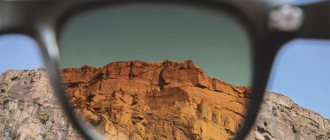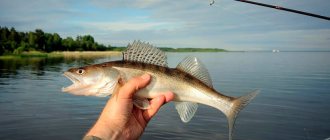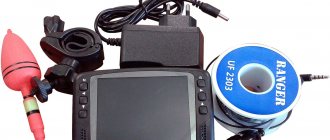The article will talk about choosing glasses for fishing. Polarized sunglasses have become one of the important attributes of every fishing enthusiast. Many fishermen use regular "beach" sunglasses with a polarizing filter and feel comfortable. But on the sunglasses market there are glasses specifically designed for fishermen.
I myself take this model of glasses when fishing, the glasses are light (you can hardly feel them), fit perfectly on your head (do not fall off), block out side rays (look at the shape of the lens) and, importantly, are cheap. In fact, this model is not glasses for fishermen, but in fact it has shown its effectiveness. Why I chose this particular model will become clear from my post, read on.
Fishing problems that every fisherman faces
Fishermen are smart and rational people, any item in the equipment has a certain functionality and works to achieve a result, the fisherman does not take anything superfluous or unnecessary with him.
An experienced fisherman cannot be fooled by “chaff”; he will not buy a product that a beautiful advertising slogan is trying to sell him. For any fisherman (whether he is a professional athlete or an ordinary amateur), the result is what matters first, not fashion or a big brand.
But it is worth noting that all fishermen experience the same problems, this is especially clearly visible on a clear day when fishing in open waters.
Here is a short list of such fishing troubles:
- fatigue and eye fatigue from the bright sun (sometimes even in cloudy weather);
- direct reflection of the sun from the water surface;
- sun glare on the water on a clear day with slight waves of water;
- specularity of the water surface, which does not allow you to clearly see the underwater world.
Further in this article, you will find answers to each item from the above list of fishing problems. If the list seems incomplete to you, then add your options in the comments to the post.
How to choose fishing glasses
When choosing polarized glasses for fishing, you need to pay attention to their color, since color rendition directly depends on this. Let's try to figure out how to choose the right sunglasses for fishing. The most popular color of such glasses is gray, since this color practically does not change the color rendition.
Keep in mind that in cloudy weather or at dusk, it is best to use glasses with light filters, since in black or gray glasses it will be difficult to see anything, since they are designed specifically for fishing in bright sun.
During bright sunshine, fishing glasses with brown filters and a green mirror coating are also an excellent option. Since they will perfectly reflect the bright and harmful rays of the sun, and the brown color will add contrast to your vision;
In cloudy weather, or when you are fishing in the shade, fishing glasses with yellow lenses are a good option. It will be quite easy to see any bite in them, and if you don’t know how to hook and land fish, then read about it here.
Polarized sunglasses and fishing
According to the “Wave Theory of Light”, a light beam is a collection of transverse waves, the planes of vibration of which are not ordered in any way. This can be felt especially expressively on a clear sunny day, looking at the water ripples, when the glare of the sun on the surface of the water makes you want to close your eyes or turn away. If you fish under such conditions, then your eyes are very strained and it is difficult to concentrate on important details, thus some of the important information is unknown to you. A polarizing filter (correctly oriented) cuts out that part of the rays that interfere with your vision. You can read more about polarization and determining the presence of a polarizing filter in sunglasses in the article “How to check polarized glasses”
Simply put, sunlight reflected from the surface of the water and entering the fisherman’s eyes is partially polarized, i.e. has interference with the eye's perception of the normal picture, the presence of sunglasses with a polarizing filter that cuts off the light reflected from the water, and allows your eyes not only to comfortably look at the surface of the water, but also, if desired (provided that the water in the reservoir is transparent) to see what occurs under the water surface near you.
The choice of filter color and degree of darkening also matters
And the matter is not limited to choosing brightening glasses for cloudy weather or dark sunglasses for bright, sunny weather. For example, copper-colored lenses contrast greens well - for example, underwater vegetation is clearly visible in them, while brown and gray lenses provide the most correct color rendition.
“If you prefer correct, undistorted color reproduction, then your choice should definitely be gray or brown filters,” says Drew Simmons, a consultant for the largest optical lens manufacturer, Action Optics.
If you are looking for results, and not chasing appearance, then, after reviewing many different light filters, you will definitely choose the one in which you will be most comfortable. Don't pay attention to appearance - focus only on your impressions.
By and large, you need to have not one, but two pairs of glasses - for sunny and cloudy weather, and such a set will allow you to fish comfortably in almost any circumstances. One of the most popular filter colors among fishermen is yellow (amber).
Yellow filters are an ideal choice for cloudy days; they are also good on overgrown bushes, small and narrow streams, where, due to excess vegetation, there is usually never too much light. Simmons does not recommend using yellow glasses in clear weather because of the danger of “overexposure” - it will hurt your eyes.
Another popular color is green-brown mirror. This is a complex recipe - the filter has a permanent brown color, and a film painted in a mirror green color is applied to its outer surface.
“This is a great choice for bright, sunny days,” says Simmons. “Such polaroids not only polarize sunlight and remove glare that makes it difficult to see through the water, but also reduce the intensity of sunlight entering the fisherman’s eyes, and also make objects in the water more contrasting, for example, they are more visible in such glasses movement of fish and artificial bait.”
Translator's comment:
1. Regarding polarized lenses: What is polarized light? Polarization of light is a set of wave optics phenomena in which the transverse nature of electromagnetic light waves is manifested. An electromagnetic light wave is called plane polarized if the oscillations of the vectors B and E in this wave are strictly fixed and lie in certain planes.
A plane polarized light wave is called plane polarized light. Light waves of natural solar radiation oscillate and propagate freely in all directions of space, while the light beam is circulation-symmetrical relative to the direction of its propagation. Such light is called unpolarized. Devices that serve to convert natural light into polarized light are called polarizers.
The simplest polarizer is a tourmaline crystal, which has the ability to transmit light waves with oscillations of the vector E (and, accordingly, B) lying in a certain plane. In natural nature, there is also a place for the polarization effect - some particles or surfaces tend to partially or completely polarize light, depending on the initial angle of incidence and the nature of the reflecting surface.
Bright horizontal surfaces, such as water, wet asphalt, sand, snow, ice, and car bodies, are the main sources of light polarization in our environment. When light hits a surface like this at a certain angle, it is reflected and becomes polarized. Polarized light creates what is called optical interference, or glare.
These disturbances reduce visibility, cause a person to squint, and interfere with driving, skating, fishing, and many other situations. The best way to combat this phenomenon is to use polarizing filters integrated into the lenses of the glasses.
The basis of polarized lenses is a polarizing filter film. Such a filter is obtained in this way: An organic film of polyvinyl alcohol is heated and then stretched, as a result of which its molecular structure is oriented parallel to the direction of stretching. Next, the film is passed through a weak solution of iodine, the molecules of which diffuse into oriented molecular chains, forming a polarizing filter.
High-quality polarized lenses are made by laminating a filter film between two lens halves, rather than applying a single lens to the surface.
2. Regarding the material for spectacle lenses: The main requirement that fishing and sports spectacle lenses must satisfy is high resistance to impact loads, so the main material for their manufacture is polycarbonate.
Initially, polycarbonate was created for the needs of the aviation and space industry, namely the glazing of windows, but later its exceptional impact resistance led to its widespread use for the manufacture of safety glasses, helmets and shields.
The first lenses made of polycarbonate appeared on the market in the late 80s of the last century, and currently, spectacle lenses of almost all possible refractions and designs are produced on its basis.
Polycarbonate has a refractive index of 1.59 and is a highly refractive organic optical material. Its specific gravity is 1.20 g/cm3 and its Abbe coefficient is 30.
Polycarbonate is a fairly soft thermoplastic material, so finished lenses must have hardening coatings on both sides. To ensure high quality and reliable adhesion, coatings are applied directly at the manufacturer.
The semi-blanks have hardening coatings on the base side, so the optical laboratory processing the half-blanks is responsible for applying the coating to the inner side.
Not long ago, polycarbonate had a competitor. has released a new material, Trivex, which is not inferior in impact resistance to polycarbonate, but has a higher Abbe coefficient and, therefore, better optical properties.
Currently, two companies have acquired the right to manufacture eyeglass lenses from Trivex: HOYA (under the brand name "Phoenix") and Younger Optics (under the brand name "Trilogy"). In addition to the high impact resistance and optical performance, athletes wearing lenses made from the new material will certainly appreciate their exceptional lightness, since the specific gravity of Trivex is only 1.11 g/cm3. At the same time, Trilogy considers them not only as lenses for sports, but also as lenses that replace lenses made from traditional CR-39-based plastics.
The largest manufacturers continue to search for new organic materials that are highly resistant to impact. At the MIDO exhibition in Milan, the Italian company presented a new development: NXT material for the production of spectacle lenses for sunglasses and sports glasses.
NXT are organic polymers based on urethane. These materials, which have high optical quality, far exceed all those currently known in terms of impact resistance, durability, and low specific gravity.
New polymers combine well with all known frame materials and are easy to process - turning, drilling - without the slightest cracking. Lenses made from new materials retain all the advantages of traditional thermoset plastics: high optical characteristics, resistance to scratches and chemical solvents.
Organic polarized lenses are produced by polymerization in a special form: the filter film is treated to improve adhesion and placed in a mold into which a reaction monomer mixture is fed from both sides. During the polymerization process, the filter becomes an integral part of the lens.
Mineral and organic lenses are also made by bending: a plane-parallel lens blank is cut out of sheet material and placed into a shape of a given curvature. The mold with the workpiece is heated until its surface takes on the required curvature. For mass production of planned organic polarized lenses, a pressing method is used.
Choosing lens material for polarized fisherman's glasses
On the sunglasses market there are both glass lenses and lighter plastic ones; each material has its own advantages and disadvantages. The main advantages of glass lenses include good wear resistance (this is important when using glasses for fishing) and, accordingly, a longer service life. The production technology of polarized glass lenses is as follows: a polarizing filter film is located between two layers of glass, respectively, the polarizing filter is protected and will work for the entire service life of the sunglasses, unlike some plastic lenses where the polarizing film is often located on top of the lens itself and over time the filter stops working properly.
The main disadvantages of glass lenses include a low level of safety; when broken, a glass lens breaks into fragments that can damage the eye; in some countries of the world, glass lenses are prohibited from being installed in glasses for children. Also, the disadvantages of using glass lenses include greater weight, which is also likely to put pressure on your nose compared to a plastic lens; the latter are more popular among fishing enthusiasts. With a greater weight of the lens, there is a high probability of discomfort when wearing, if you feel discomfort from sliding down the bridge of your nose due to the weight of the glass lenses or from the pressure of the glasses, then most likely this fact will distract you, so why do you need such glasses at all? The biggest advantage of polarized lenses made of plastic, or rather polycarbonate, since most optical manufacturers make plastic lenses from polycarbonate, is the ability to shape the lenses into almost any curvature, which contributes to a good panoramic view, which is very important when fishing. Polycarbonate lenses are much lighter than their glass versions and allow manufacturers to make sunglasses almost weightless and nothing will distract you from peacefully watching a bobber bob on the wave. The technology for producing polarized lenses from polycarbonate largely depends on the technology and know-how of the lens manufacturer; some manufacturers make a special polarizing filter in the form of a film located on the surface of a polycarbonate lens; more serious manufacturers achieve a polarizing effect due to the special molecular properties of the lens material, with this approach The polarizing filter will work for the entire life of the sunglasses. There are legends about the safety of polycarbonate lenses, but it is enough to know that Oakley polycarbonate lenses have proven themselves to be excellent and are used by Americans in war.
The disadvantages of polarized lenses made of polycarbonate include the fact that they are still plastic and are not as resistant to abrasives (sand, dust, etc.) which are found in abundance during fishing like glass lenses, but today most manufacturers make lenses capable of adequately cope with difficult fishing conditions. When choosing sunglasses for fishing, it is not recommended to purchase glasses that the manufacturer recommends for use on snowy slopes for skiing; they may not have sufficient resistance to abrasives, and this is understandable, because the likelihood of getting into a dust storm at an alpine resort is quite small. Choosing sunglasses for fishing is required solely taking into account your comfort, and not with an eye on the materials from which they are made; most world-famous manufacturers care about their reputation and simply will not produce products that will harm you. Today, technology makes it possible to make fairly strong lenses from glass and very good eye protection from polycarbonate, but comfort during long-term wearing is the only factor that is individual.
Which model should you choose?
Upon closer inspection, the outwardly similar glasses are very different. “Many fishing sunglasses have very flimsy frames,” says professional angler Gary Dobyns. “And this means that if you use them often enough, such glasses will not last even a few months.”
The first thing you should pay attention to when choosing sunglasses is the presence of a polarizing filter.
Fishing glasses should not just be dark, they must be polarizing, because the whole point of fishing glasses is to eliminate glare on the water that prevents you from seeing what is happening under the surface film - in the water column and at the bottom
It is the polarization of light, carried out by appropriate light filters, that allows you to “look” under the water at a certain position of your head. If the glasses you choose are simply tinted, then you simply will not get such an effect.
“If you don’t use Polaroids, consider that you’re not even trying to fish,” made an almost policy statement from Jerry Dobyns, a multiple champion in bass fishing, very popular in the Western States.
“With glasses, you see everything that happens underwater - vegetation, rocks, snags and, finally, fish.” “So when I'm choosing lenses, the first thing I think about is whether they have a polarizing membrane. Secondly, the lenses must be of the highest quality, absolutely transparent (we are not talking about tinting - translator’s note).”
Jerry's current favorite product is Costa Del Mar Harpoons. Dobbins emphasizes that when purchasing glasses, you should always give preference to products from well-known manufacturers that have proven themselves in the market. Pay attention to things like the warranty.
Don't focus on price and look for the cheapest offer. Glasses are not a fishing rod, you only need them - and for a long time. Damaged vision or complete lack of visibility is not a price worth paying for the money saved on quality glasses.
“A quality frame is also important,” says Jerry. “Most fishing polaroids have inherently weak frames.” Just a few months of use can damage the glasses. Many plastic frames last a month and then fall apart.”
“The frame must fit well and not cause discomfort. My glasses stay still in almost any situation, whether I'm walking or standing. Even if I ride my motorcycle at 75 mph, the glasses won't move. In this case, the frame should not press. Once you spend a day on a pond in a tight, uncomfortable frame, you won’t need all the fish in the ocean for nothing. It is very important".
What color should the lens of glasses suitable for fishing be?
Oddly enough, but most often for polarized glasses, gray lenses are more common than, for example, pink. A truly gray lens works very effectively in high light conditions in sunny weather and, moreover, practically does not distort the colors of objects, which is why gray lens color is so popular. Sunglasses with gray lenses are ideal for everyday wear, all-weather, so to speak, with a polarization coefficient of approximately 99%. It will be good if you allow yourself to buy several polarized sunglasses with different lens colors, but we’ll talk about this in more detail. Copper-colored lenses make objects more contrasty, mute the blue color and seem to enhance visual acuity, excellent for fishing in sunny weather, polarization coefficient is approximately 99%.
Brown lenses, according to many fishing enthusiasts, are optimal, as they combine ideal contrast and, like gray lenses, convey the true colors of objects well. Brown polarized lenses are recommended to be worn both in bright sun and in light clouds; the polarization coefficient is approximately 99%. Amber lenses are less popular among anglers but have a unique feature. On cloudy days, the amber color of the lenses is optimal, and lenses of this color are also popular among fans of brook trout fishing (they have an optimal transmission spectrum for visual detection of this fish), the polarization coefficient is approximately 95%. Pink lenses are very rarely found both on sale and on the faces of fishing enthusiasts. The main advantage of these lenses is fishing in the evening in low natural, artificial or mixed lighting, on pond farms or urban reservoirs. Recognition of a float made in red-orange tones is made clearer and more contrasting, the polarization coefficient is approximately 50%.
Polarized Fishing Glasses
WALK FISH WFG01 – leader in the number of reviews
They fit well and don't press. Comfortable to wear due to weightlessness. Classic design. 12 colors of lenses and frames.
View on Aliexpress
Description:
- gender – male/female;
- lens parameters – height 4 cm, width 6 cm;
- polarization – yes;
- Lens material – plastic.
The advantage is fast delivery from China. Disadvantage: they are not suitable for round faces.
DUUTI 831C2SS100470 – budget option
Comfortable fit. In sunny weather the glasses do not dazzle. Visual acuity improves in the area of the float, which is 10-15 meters away.
View on Aliexpress
Description:
- purpose – fishing, outdoor activities, cycling;
- optics material – plastic, frames – metal + plastic;
- colors – black, brown;
- parameters – distance between arms 14 cm, optics 4.2x6.6 cm.
Reedocks C-P6001N – one of the top popular models
Combination of affordable price and high protective properties. Universal size. Dark lenses are recommended for summer. Yellow and orange glasses are suitable for daily wear.
View on Aliexpress
Description:
- optics material – plastic;
- parameters – 6.3x4.4 cm;
- polarization – yes.
The glasses fit well on wide to average faces. The plastic is thin and requires careful handling.
QUISVIKER tops the ranking of best-selling products
QUISVIKER products are of high quality. Comfortable to wear, no discomfort. The eyes don't get tired. Plastic does not have an unpleasant chemical smell.
View on Aliexpress
Description:
- gender – men/women;
- case width – 13.2 cm;
- glass parameters – 6x4 cm;
- purpose – fishing, cycling;
- color options – 12.
The plastic, according to users, is thin, so careful handling is necessary.
DAISY X7 – with interchangeable lenses
The lot is presented from polarized copper-brown glasses and three pairs of glasses in gray, yellow, and transparent colors. The acetate frame has windproof elements. The kit also includes straps (replacing the temples + on the temples).
View on Aliexpress
Description:
- optics parameters – impact-resistant plastic;
- gender – unisex;
- glass parameters – 6.5x4 cm;
- Purpose – tourism, fishing, cycling.
Daiwa 1414 – new 2021
Polarization ensures good visibility at night, in cloudy weather, and in water. Light weight. Beautiful colors of plastic glasses. The design is modern.
View on Aliexpress
Description:
- Purpose – mountaineering, outdoor activities, sports;
- color options – 10;
- the distance between the arms is 14.7 cm;
- complete set: soft case, napkin.
There is a slight smell after unpacking. It will disappear within 2-3 days.
OOTDTY Night Vision Glasses – lowest price
The model is intended for travelers, athletes, fishermen. Polarization increases visual acuity in the dark and provides protection from glare. The frame fixes only the upper part of the glass. This makes the glasses weightless.
View on Aliexpress
Description:
- gender – unisex;
- the distance between the arms is 14.5 cm;
- type – night vision;
- material – impact-resistant plastic.
Cycling sunglasses – comfortable fit
Plastic glasses have a polarized film, which creates protection from ultraviolet radiation and glare. Suitable for outdoor activities, tourism, sports.
View on Aliexpress
Description:
- glass dimensions – 4.1x6.3 cm;
- shape – oval;
- material – TAS;
- weight – 21 g.
The seller provides a detailed overview of the model. You can choose a color from seven options.
Daiwa KJN567 - the best protection against UV rays
Mid-priced model. The main material is impact-resistant plastic. The earpieces tightly cover the area behind the ears, but do not put pressure. The glasses do not slip off while moving.
View on Aliexpress
Description:
- protection level – UV400;
- optics dimensions – 6.3x4.9 cm;
- the distance between the arms is 14.5 cm.
The model is suitable for a round face. Universal size.
WALK FISH FB001 – lightweight universal
Unisex model (suitable for men and women). The main material is durable plastic. The concave shape of the frame ensures a good fit.
View on Aliexpress
Description:
- the distance between the arms is 13.2 cm;
- glass parameters – 6x4 cm;
- color options – 12.
They don't fit well on a round face. The seller ships in bubble wrap. There are complaints about backlash.
Where to buy polarized glasses for fishing
Unlike regular sunglasses, which can be bought at any decent optical store, good fishing glasses will have to be found.
Polarized fishing glasses can be purchased from the following physical stores:
- Trial Sport - presented in many cities of Russia;
- Kant - this sports store has been operating since 1989 and is represented in some cities of Russia;
- Decathlon is not a very large choice, but they do have polarized covers for glasses;
- Sport Master is a federal chain of sports stores, there is a Polaroid brand.
Polarized glasses for fishing can be purchased in the following online stores:
- lamoda - wide selection of original Polaroid models, most models with polarization, delivery throughout Russia;
- Kant - a very large selection of sunglasses, most of which are suitable for fishing;
- Decathlon - the choice of brands is small, but the prices are low, this online store has polarized covers for glasses;
Polarized Anti-Glare Fishing Glasses
On a hot summer day, when the sun shines high, casting its rays on the surface of the water, it becomes more difficult to observe the float, especially if it is not near the shore. In this case, only high-quality anti-glare polarized glasses for fishing can help, and not Chinese fakes. Because it is high-quality, and therefore expensive, glasses that will help not only improve visibility in sunny weather, remove glare coming from the surface of the water, but also protect your eyes from the harmful effects of ultraviolet rays.
An amazing fact is that with the help of such glasses you can literally see what is happening “underwater”, but this, of course, depends on the degree of transparency of the reservoir and the level of lighting. In these conditions, glasses will help remove various refractions or reflections of the sun's rays from the visibility zone.
Cost of polarized sunglasses for fishing
The range of prices for sunglasses with a polarizing filter is quite large, but behind each price is quality, service life and your comfort while fishing. Sunglasses with a polarizing filter can be bought for either 5 dollars or 500; in the first case, they will most likely sell you noname glasses with a polarizing filter that will not work in a month or it will be missing altogether (how to check for the presence of a polarizing filter, read this article), perhaps this is not a bad choice for a week's relaxation on a sun lounger, although this is also debatable. As a rule, $5 glasses are not glasses specifically designed for anglers, but are cheap copies of the most popular and fashionable sunglasses of the moment. Not all companies that manufacture sun protection optics produce glasses for fishing, and models for fisherman have their own nuances and subtleties. It is very convenient when the lens has a good view or the frame is structurally equipped with side curtains that protect from side rays; sometimes the manufacturer of fishing glasses completes the glasses with a special cord or elastic band that will help prevent the loss of glasses, as well as a cover that protects them from dust and partially from mechanical damage during transportation.
Polarized glasses for fishing rating
Most branded fishing glasses are made with high quality and fully meet the stated characteristics, so it is quite difficult to build an objective rating. It would be more logical to divide manufacturers by price
If you have used this or that brand of glasses, I suggest you vote for it in the comments. If the brand of your favorite glasses is not included in the review, add it in the comments to the post.
Fishing glasses rating, low price
- Snowbee;
- Flying Fisherman;
- Balzer;
- Aqua;
- Ale Lunettes;
- Action Optics;
- Shimano;
- Gamakatsu;
- Rapala;
- Polaroid;
- Jaxon;
- Solano;
- Brenda;
- Fenwick.
If handled carefully, sunglasses from these manufacturers will last you a long time. The plastic lenses on these sunglasses are, of course, less scratch resistant than glass, but still hold up well over several seasons of use in the most extreme fishing conditions.
Fishing glasses rating, high price
- Orvis;
- Costa;
- Smith;
- RX;
- Oakley.
The use of special plastics and lens processing technologies makes the glasses on this list quite reliable, and if you follow simple handling and care rules, the sunglasses of these brands will practically last forever.











